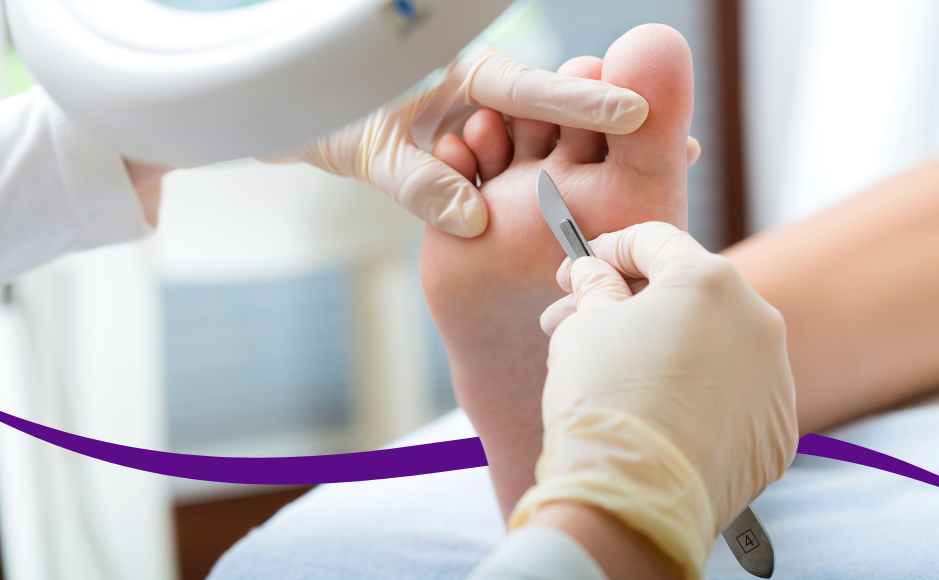

We call it deep vein thrombosis (DVT); you may have heard it called a “blood clot in the leg”. Either way, DVTs are one of those things that are incredibly important to know about so you can learn the signs and understand your risks, given that developing a blood clot can have some severe consequences. And if you’re a jet setter (or even a long commuter), then you definitely need to know about deep vein thrombosis. Here’s the lowdown from our podiatrists.
A DVT describes a blood clot that forms in the deep veins, usually in the calves or thighs. Other areas of the body with a ‘deep vein’ can also get a DVT, such as in the pelvis, arms, abdomen, or even the chest, but these occur much less frequently.
DVTs (blood clots) are a concern during flights because sitting still for long periods—often in cramped seats—slows down blood flow in the legs. A lack of movement greatly increases the chances of a clot forming, which is why doing long drives in a car (greater than four hours) also carries similar risks.
If that blood clot breaks loose, it can travel through the bloodstream to the lungs, causing a blockage called a pulmonary embolism, which can be life-threatening. Long flights, with extended sitting times and reduced mobility, make DVT a real risk.
To better understand the likelihood and effects of a DVT, according to the research, there’s approximately one case of DVT per 1000 people, which makes it relatively common for something that can have quite serious consequences. It’s also the underlying source of 90% of acute pulmonary embolisms, which cause 100,000 deaths per year in the United States.
In terms that are closer to home, approximately 30,000 Australians have a DVT each year. Blood clots are also responsible for an estimated 10% of all deaths in Australia, and yet up to 70% of these are preventable.
If you have an active deep vein thrombosis? No, that generally is not considered safe unless you’re cleared by a doctor. The limited movement and prolonged sitting during a flight means that your risk of blood clots growing larger or breaking loose, potentially leading to a pulmonary embolism like we described earlier. If you have a DVT and need to travel, you’ll definitely need to speak with your doctor and vascular specialist about how to best keep you safe and minimise your risks.
If you’re at risk of a DVT? Then flying can still be safe, but your doctor will likely advise you to take several precautions. It'll be more important to drink plenty of water, move your legs regularly, avoid alcohol, and take short walks during the flight to promote blood circulation. Your doctor may also recommend compression stockings for you (we do!) to reduce swelling and improve blood flow.
Just to be clear, if you have a DVT or have any concerns about blood clots, you need to speak with your doctor or vascular specialist.
Here’s a comprehensive list of risk factors from a medical journal published last year - we’ve made it easy to understand if you have an increased risk of a DVT:
The most common signs and symptoms include swelling, pain, and changes in skin colour or temperature in the affected leg. Swelling is often one of the first noticeable signs and usually occurs in one leg, most frequently in the calf or thigh. This swelling can appear suddenly and worsen over time. The leg may feel tight, and clothes or shoes might fit more snugly than usual.
If pain is present, it’ll range from a dull ache to sharp, intense discomfort. It often starts in the calf and may feel like muscle cramping or soreness. This pain may be more noticeable when standing, walking, or applying pressure to the area. Tenderness is also typical, especially in the calf or inner thigh. Touching the area may cause discomfort or a heightened sense of pain.
In addition to swelling and pain, you might notice skin changes over the affected area. The skin may appear red, bluish, or darker than the surrounding area, and the affected leg may feel warm.
In some cases, veins near the skin's surface can become more visible or appear swollen. These symptoms can develop gradually or suddenly, so you’ll want to get help quickly if you notice these signs.
To prevent DVT during flights, focus on keeping your blood circulation active throughout the journey:
If you suspect DVT mid-flight, it’s important to take immediate action to reduce the risk of complications, as it can be potentially life-threatening. Start by moving your legs and feet to promote blood circulation. While seated, perform gentle exercises such as ankle circles, heel raises, or foot pumps. This can help keep the blood flowing in your legs and potentially prevent the clot from worsening.
If possible, stand up and walk around the cabin periodically. Movement is key to promoting blood flow, which can alleviate some symptoms and reduce the risk of the clot growing larger. Keep drinking water, and alert the flight crew about your symptoms so they can provide support and be prepared for any emergencies. Once you land, get to a doctor quickly.
If you have a DVT, there are several things you should avoid to prevent complications:
If your doctor prescribes blood thinners or other medications, do not stop taking them without consulting your doctor. Stopping medication prematurely can increase the risk of the clot growing or new clots forming.
As podiatrists who have seen our fair share of DVTs and have chatted with patients who have been through the experience, the resounding message is that it’s always best to be safe. It’s much better to raise the alarm if you suspect a DVT and then get to breathe a big sigh of relief when you learn that everything is fine than shrug off a DVT to discover severe consequences for your health. Keeping educated on identifying a DVT and knowing how to reduce the risk of a blood clot is a fantastic first step.
Have questions or concerns about your lower limb health? Our podiatrists are here to help. We have two clinics across Brisbane CBD and Newmarket, and you can book an appointment by calling us on (07) 3356 3579 or booking online here.
| Monday | 7:40am - 6:00pm |
| Tuesday | 7:40am - 6:00pm |
| Wednesday | 7:40am - 6:00pm |
| Thursday |
7:40am - 6:00pm |
| Friday | TEMP CLOSED |
| Saturday | CLOSED |
| Sunday | CLOSED |
Ground Floor, 344 Queen Street,
Brisbane City QLD 4000
| Monday | 7:40am - 6:00pm |
| Tuesday | 7:40am - 6:00pm |
| Wednesday | 7:40am - 6:00pm |
| Thursday |
7:40am - 6:30pm |
| Friday | 7:40am - 5:00pm |
| Saturday | 7:40am - 4:30pm |
| Sunday | CLOSED |
Newmarket Village, 114/400 Newmarket Rd, Newmarket QLD 4051